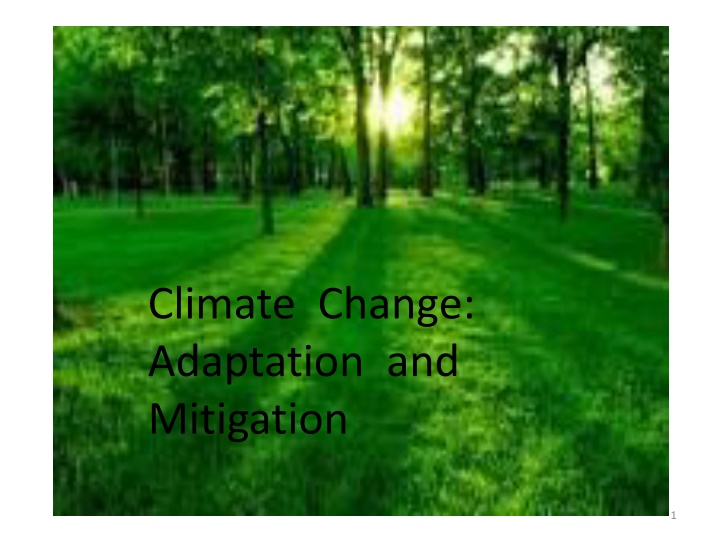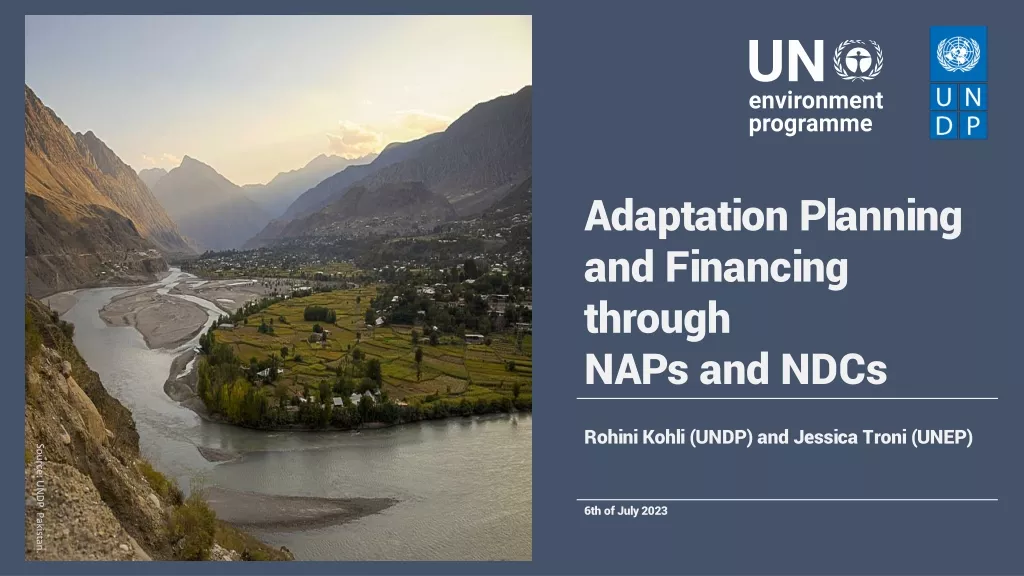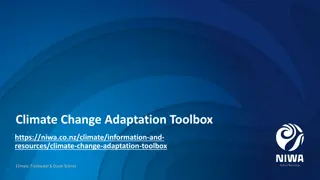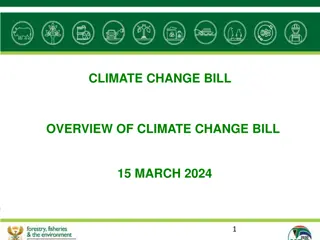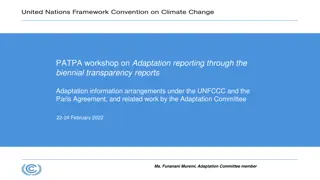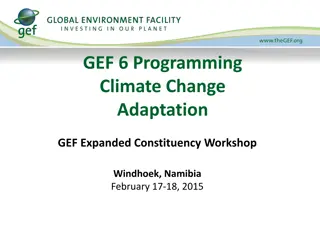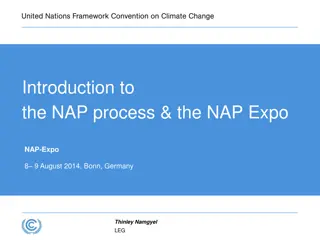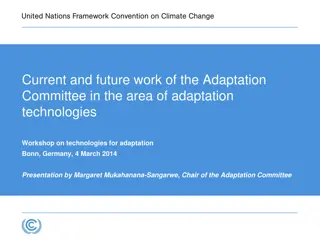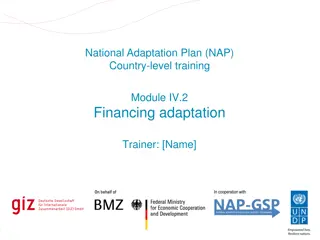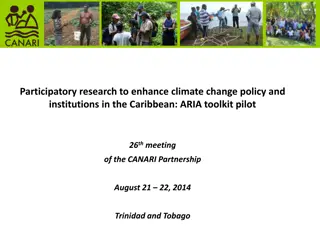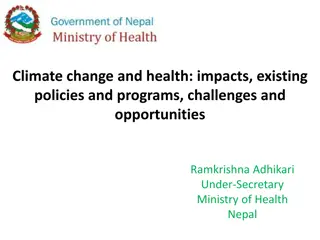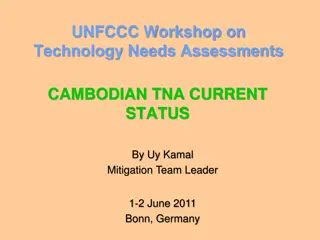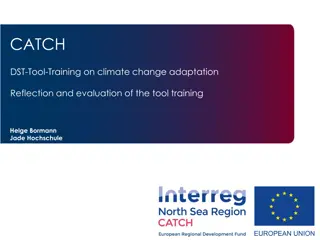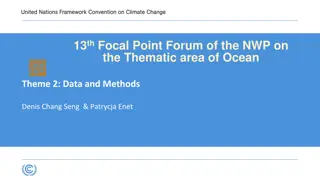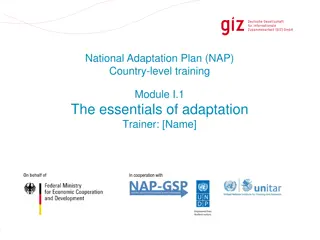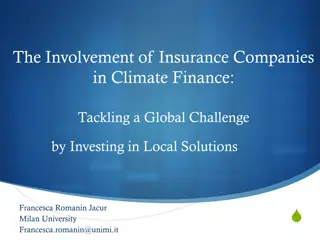Climate Change: Adaptation and Mitigation
Climate change affects ecosystems and socio-economic systems, but developing countries face challenges in adapting. Mitigation is crucial, requiring collective action at individual, institutional, and national levels. Adaptation involves adjusting to climate change through policies, technology, and awareness creation at both country and local levels. Addressing the impacts of climate change includes creating plans and self-developed methods. Mitigation aims to reduce the impact of climate change through measures like increasing energy efficiency and phasing out fossil fuels.
Download Presentation

Please find below an Image/Link to download the presentation.
The content on the website is provided AS IS for your information and personal use only. It may not be sold, licensed, or shared on other websites without obtaining consent from the author.If you encounter any issues during the download, it is possible that the publisher has removed the file from their server.
You are allowed to download the files provided on this website for personal or commercial use, subject to the condition that they are used lawfully. All files are the property of their respective owners.
The content on the website is provided AS IS for your information and personal use only. It may not be sold, licensed, or shared on other websites without obtaining consent from the author.
E N D
Presentation Transcript
Climate Change: Adaptation and Mitigation 1
Mitigation and Adaptation : A study of Solutions To climate Change Issues By Dr Bandana Pathak Asst Professor in Economics S.B.Women s Autonomous College, Cuttack Email id- pathakm2012@gmail.com, cell-9861156534 2
The Problem Climate change affects the balance of natural eco-systems (i.e. forests, river basins, sea level) and socio-economic systems (i.e. agriculture, fisheries, irrigation and power projects). The lack of resources, technology and finances in developing countries such as in India have limited capacity to develop the adaptation strategies which are vulnerable to climate change and least able to adapt . disproportionately 3
Mitigation According to the IPCC's 2014 assessment report, "Mitigation is a public good; climate change is a case of the 'tragedy of the commons'. Effective climate change mitigation will not be achieved if each agent (individual, institution or country) acts independently in its own interest 4
Individual: Awareness is to be created Institutions: The causes are to be reduced Country: Policies are to be implemented 5
Adaptation Adaptation means the actions that are taken to adjust to Climate Change, moderate potential damages consequences. It is therefore a blend of policy and technology, and how fast they can be implemented. Adaptive capacity can be both, at the country and the local level. or cope with its 6
At the Country level: Plans are to be created and awareness is to be generated At local level: With awareness creation some own self developed methods are to be created 7
Impact of climate change a change in average temperature levels a change in average rainfall levels a change in the number of dry days 8
Mitigation Mitigation is the process through which economy tries to reduce the evil impact of climate change. Examples of mitigation include reducing energy demand by increasing energy efficiency phasing out fossil fuels by switching to low- carbon energy sources removing carbon dioxide atmosphere from Earth's 9
The IPCC Fifth Assessment Report emphasizes that behaviour, lifestyle, and cultural change have a high mitigation potential in some sectors, particularly when complementing technological and structural change. In general, higher consumption lifestyles have a greater environmental impact. Several scientific studies have shown that when relatively rich people wish to reduce their carbon footprint, there are a few key actions they can take such as living car-free (2.4 tonnes CO2), avoiding one round-trip transatlantic flight (1.6 tonnes) and eating a plant-based diet (0.8 tonnes). Nicholas Wade (2017) 10
Methods of Mitigation Renewable and Alternative energy sources Lifestyle and behavior Food Habit Conservation of Energy 11
Energy Efficiency Conservation of Energy Efficient energy use, sometimes simply called "energy efficiency", is the goal of efforts to reduce the amount of energy required to provide products and services. For example, insulating a home allows a building to use less heating and cooling energy to achieve and maintain a comfortable temperature. Installing LED lighting, or natural skylight windows reduces the amount of energy required to attain the same level of illumination compared to using traditional incandescent light bulbs. LED lamps use only about 10% of the energy an incandescent lamp.
Climate change Mitigation Measure in India India is one of the world s largest economy and fifth largest greenhouse gas (GHG) emitter accounting for about 5% of global emissions. India s emission increased 65% between 1990 and 2005 and are projected to grow another 70% by 2020
Adaption Priorities Agriculture under pressure Protecting fresh water supplies Climate impacts on health Risk on energy Sector Fisheries and local livelihoods Reducing risks from extreme weather 14
Adaption Programme In this connection the study highlights some of the program of adaptation collected through secondary sources Adaptation goals for coastal climate change Functional and healthy coastal ecosystem Coastal wetland protection and restoration Marine conservation & protected area- Increasing robustness of infrastructure (built environment is less exposed) Building standards- Structural shoreline stabilization- It is about temporary buffer against erosion Diversified livelihoods 15
Financing the Adaption programme Effective Implementation depends on policies and cooperation at all scales and can be enhanced through integrated responses that link mitigation and adaptation with other societal objectives Common enabling factors and constraints for adaption and mitigation responses Response options for Mitigation Policy approaches for adaptation and mitigation, technology and finance International and Regional Co-operation on Adaptation and Mitigation. 16
Adaption to climate change in developing countries UNDP supports in climate change adaptation includes integrating information on climate change risk and adaptation options into national and sub-national planning processes and budgets and promoting and implementing integrated investments on the ground that safe guard livelihoods and protect development from possible impacts. 17
Climate change issue in Odisha Odisha s particular vulnerability to climate change impacts of sea level rise, increased storm intensity, extreme droughts and heat waves, and increased wind and rainfall events. It once again recognized that human activities such as coastal development, burning of fossil fuels, and increasing greenhouse gas (GHG) emissions are contributing to the causes and consequences of climate change. Gas Emissions Report 2007 The carbon footprint study indicates that the state has emissions of 98.525 megatons of CO2 equivalent (baseline year 2011-12). The per capita emissions of the state are 2.35 metric tonnes, which is higher than the national average of 1.7 metric tonnes (estimated as per 2007 baseline as presented in2010-15 SAPCC).To reduce emissions and follow a low- emission growth strategy CII has made 11 specific recommendations many of which are listed as a part of the SAPCC 2018-23 planned actions. Sector CO2-Equivalent Megatonnes 18
Table - Comparison of GHG emission in Last Five Years, Odisha, Source : SAPCC 2010-15 and CII GHG inventory study, 2015 a. Agricultural emissions were not computed in the last SAPCC in line with the India government s position of excluding the agriculture sector from the national communication. b. Industrial waste was not included in the last SAPCC computation. CO2 equivalent megatonns CO2 equivalent Sector megatonns As per SAPCC I As per CII Study ((2010-2015) for Base year 2011-12 109.77 25.07 0.66 135.49 -36.9 98.52 2.35 Industry, Transport, Energy Sector Agriculture( a) Waste (b) Subtotal (A) Forest (B) Total (A+B) Per capita emission 82.68 - 0.56 83.24 -4.56 78.68 1.88 19
Impact of Climate Change in Odisha Impact on Agriculture The adverse effects of climate change falls heavily on climate sensitive agricultural sector. Studies have predicted that agriculture yield will likely be severely affected over the next hundred years due to unprecedented rates of changes in the climate system. 20
Impact on Industry The economic growth of Odisha since 2005-06 has been mainly induced by the growth of the industrial sector. Odisha s substantial mineral resource endowments have led to the growth of metallurgical and non-metallic mineral based and other energy intensive manufacturing industries in the state. Given the resource base of the state, twelve industrially active zones have been developed across the state, viz., Rourkela-Rajgangpur, Ib valley and Jharsuguda area, Hirakud, Talcher-Angul, Choudwar, Balasore, Chandikhol, Duburi, Paradeep, Khurda-Tapang, Joda-Barbil and RayagadaThe growth in an economy, when fuelled by the growth in the manufacturing sector, usually puts additional pressure on the demand for natural resources and contributes to climate change (Rock and Angel, 2005). 21
Climate is an important determinant of the geographical distribution, composition and productivity of forests. Forest area affected by climate change depends on various factors like species and age of trees, possibilities for forests to migrate, and quality of forest management. Climate change impacts over forestry turn to have profound implications for traditional livelihood, industry, biodiversity, soil and water resources, and these lead to changes in agricultural productivity. Impact on Wetland In Odisha, the loss of wetlands is also a key concern. The expansion of agricultural and urban areas in recent decades have reduced wetlands and contributed to changes in the hydrological characteristics of many drainage basins. These changes include an increase in river discharges, a reduction in groundwater levels and base flow discharges. water table in ecosystem. Impact on Forestry 22
Impact on Mining Mining is a major economic activity in the state and it contributes significantly to the growth process. Odisha possesses 24 per cent of India s coal reserves, 17 per cent of iron ore, 98 per cent of chromites, 51 per cent bauxite and 35 per cent of manganese. This sector provides employment to about 45 thousands manpower every year. In spite of such a contribution, mining in Odisha has serious local environmental and social impacts. 23
Impact on Human Health As the quality of life strongly depends on climate, climate change affects human amenity. Climate Change is projected to increase threats to human health, particularly in lower income populations, predominantly within tropical/sub-tropical countries (Smith, 2003). There are both direct and indirect effects of climate change on health (Patil and Deepa, 2007). The consequences of climate change on human health can be categorized as asthma, respiratory allergies and airway diseases; cancer; cardiovascular disease and stroke; food-borne diseases and nutrition; heat-related morbidity and mortality; human developmental effects; mental health and stress-related disorders; neurological diseases and disorders; vector-borne and zoonotic diseases; and water-borne diseases . 24
Government Policies and Actions Efficiency in Energy Consumption and Conservation Water Resource Management Coastal Protection Green Economy Industrial Efficiency Fiscal Strategies Public Awareness 25
Alternative Employment Opportunities for Farmers Skill Development Policies and Institutions Improved Land-use and Natural Resource Management 26
Summary and Conclusion Man made climate change is of serious concern The study highlighted the causes of global warming like fossil fuels, deforestation, mining over consumption are the reason behind climate change Apart from it the human society should build capacity and develop adaption measures so that the ill effects can be minimized There is no direct and once for all solutions to climate change but with proper utilization of mitigation and adaption measures the human beings can help themselves and to the plant life and animal kingdom, so that the entire world be benefited 27
THANK YOU 28
